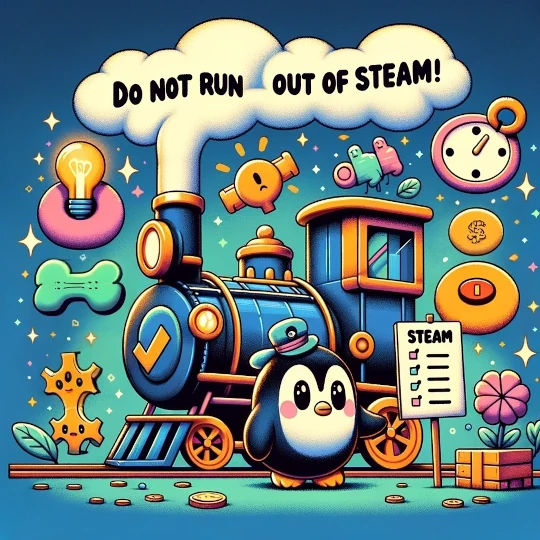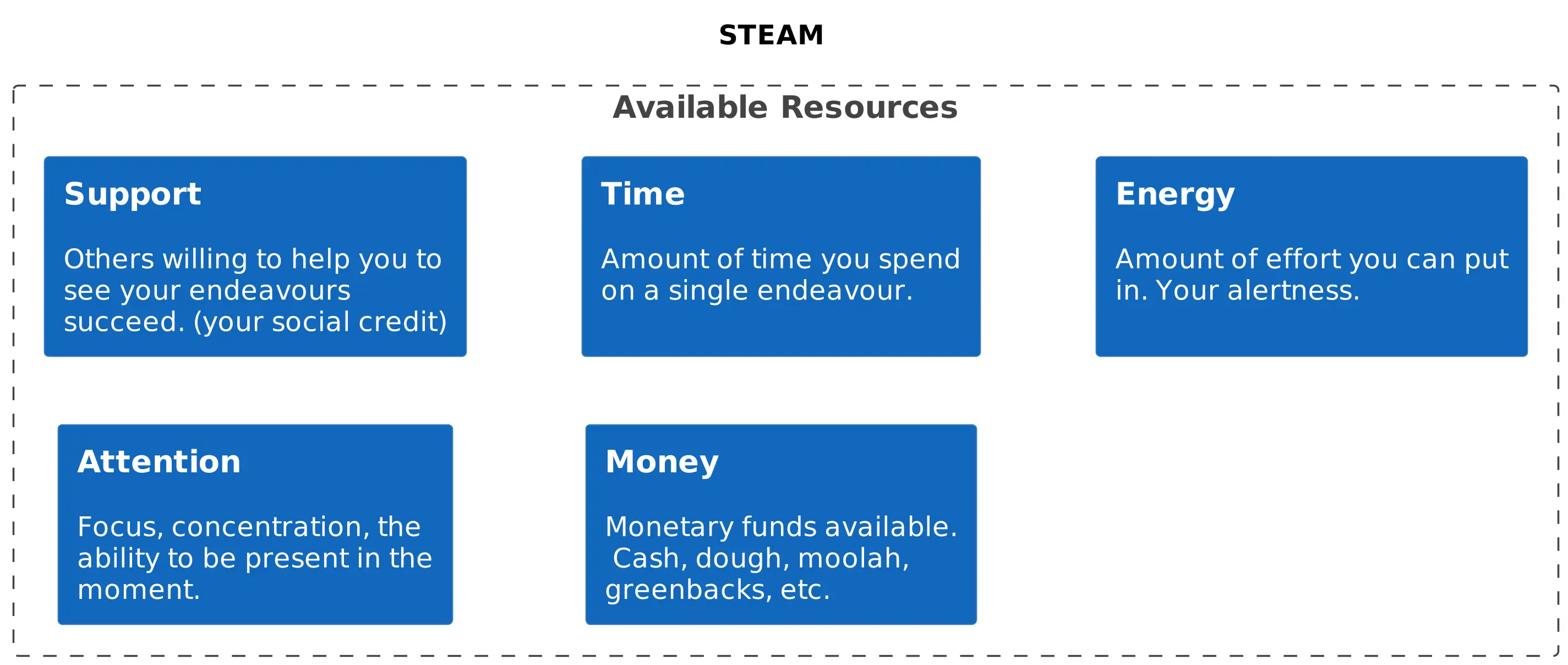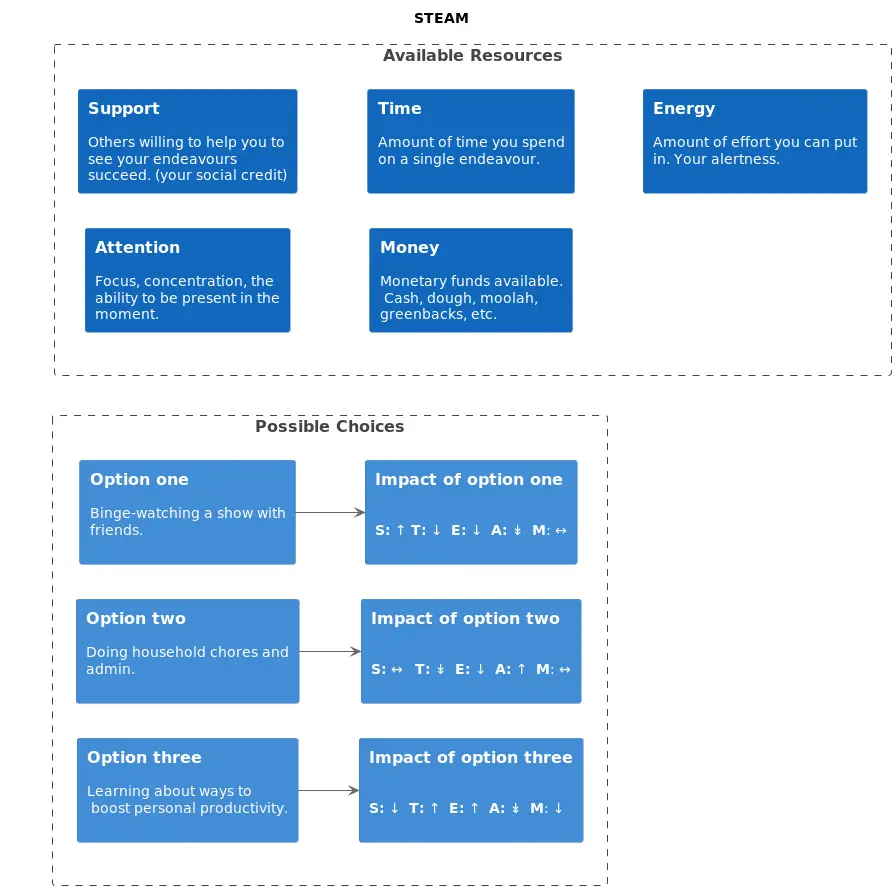Don't run out of STEAM

Problem Statement
You often struggle with deciding what to do next, feeling uncertain about which choice would be most beneficial for you.
Intent
Employ a mental framework to evaluate your options systematically, aiding in making informed decisions that align with your goals and needs.
Solution
Outline
When considering what to do next, use the STEAM framework to evaluate the possible options. The model applies an economical perspective to the resources you have available, and how you can use them to your advantage. While this way of evaluating trade-offs is not a silver bullet, it can help you to make an informed decision that suits your needs.
The STEAM framework is a mnemonic shortcut to remember your most important assets. It stands for:
- Support: Your social capital. The help of others, whom you can call upon to assist you in your endeavours or to provide you with advice. This can be in the form of a mentor, a coach, a friend, or a colleague.
- Time: The amount of time you have available to invest in activities. The baseline is similar for everyone, as we all have 24 hours in a day. How we spend this time, is what makes the difference.
- Energy: How energetic you feel. This can be influenced by your physical and mental health, as well as your emotional state. It is important to be aware of your energy levels, as they can influence your ability to undertake tasks, your performance, and the quality of your work.
- Attention: How much focus you can apply to any given task. Roughly speaking, this is your ability to filter out distractions and be engaged with the task at hand.
- Money: Your financial assets, the amount of funds you have to invest in activities, products, or services.
Steps to Implement
Summarized, the STEAM framework can be used as follows:
- Evaluate current assets across STEAM categories.
- Gain insights into resource availability and deficiencies.
- Avoid short-term optimization; consider long-term consequences.
- Assess potential actions and their impact on resource levels.
- Make decisions based on resource balance and personal needs.
- Take action confidently and reflect on outcomes for continuous improvement.
When you are faced with a decision, consider what your current assets are in each of the STEAM categories. This will give you a better understanding of what you can leverage to make to most of the situation, as will it inform you which resources are currently lacking. (ex. if you have plenty of time, but lack energy, maybe it is time for an energizing hobby). When considering these trade-offs, remember that the goal is not to maximize all categories, but to find a balance that suits your needs.
tip: Do not fall into the trap of short-term optimization. While it might be tempting to focus on the immediate gains, make sure to reflect on the mid-to-long term consequences of your decisions. This will help you to make more informed choices, and work towards sustainable growth.
Assess the potential actions you can take, and how they would impact the level of the STEAM resources you have available. Do this in any way that suits you best, be it an indication of high, medium, or low impact, or a numerical score. I personally like to use a simple scale ranging from -2 to +2, where -2 is a significant negative impact, 0 is neutral, and +2 is a significant positive impact.
Once you have written down your assessment, take a step back and reflect on the results. Do not be afraid to revisit your initial efforts, and adjust the scores if you feel they do not accurately represent the situation. Just be mindful of the fact that we are not looking for the perfect situational analysis, but for a good-enough indication to help you make an informed decision.
Armed with the list of potential options, and the impact they would have on your STEAM resources, you can now make a choice on how to proceed. Once you have made your decision, take charge and act upon it. Do not let the fear of making the wrong choice hold you back, and give it your best effort. Avoid wasting your energy on second-guessing yourself, but use it to make the most of the situation. Schedule a moment to revisit your decision at a later time, and reflect on the outcomes. This will help you to learn from your choices, and help you improve your self-awareness and decision-making skills.
Contextual forces
Enablers
The following factors support effective application of the practice:
- Understanding of personal goals and ambitions.
- Awareness of individual needs and willingness to confront them.
- Dedication to daily reflection and self-assessment.
- Preference for visual aids in understanding complex situations.
- Desire to take control of life and make decisions autonomously.
Deterrents
The following factors prevent effective application of the practice:
- Lack of clarity regarding personal goals and ambitions.
- Tendency to rely on external influences for decision-making.
- Disconnect from personal needs and avoidance of self-confrontation.
- Difficulty in self-management and lack of discipline.
- Perception of current circumstances as satisfactory, neglecting the need for decision-making refinement.
Application
Consequences
The main concern with the STEAM framework is its potential to over-complicate decision-making processes, especially for those who prefer a more minimalistic or intuitive approach. While the framework is beneficial in maintaining consistency and solving problems, it may not always be the most efficient or flexible approach, particularly when quick decisions are necessary.
- High Effort: Regular assessment and reflection can be time-consuming and require significant effort.
- Over-emphasis on Resources: Focusing too much on the resources might lead to analysis paralysis or neglect of other important factors.
- Subjectivity: The assessment of resources and their impact can be highly subjective, leading to potential biases in decision-making.
- Rigidity: The framework might be perceived as rigid, making it challenging for individuals who prefer more intuitive decision-making processes.
Mitigation Strategies
- Selective Application: Consider applying the STEAM framework only to significant decisions or when you feel stuck. This ensures that the benefits of the framework are realized without overwhelming daily decision-making processes.
- Simplification: For individuals or teams who prefer a minimalistic approach, consider simplifying the framework or adapting it to reduce complexity and effort.
- Integration with Intuition: Encourage a blend of structured and intuitive decision-making, allowing for flexibility in fast-paced environments while still benefiting from the framework’s thoroughness.
- Peer Collaboration: To mitigate subjectivity and biases, incorporate feedback from peers or mentors during the assessment process. This can help refine the resource evaluation and lead to more balanced decisions.
Examples
Evening Plans
Criticism & Clarifications
- STEAM is a thinking aid, not an optimisation algorithm—capture the reflections but trust yourself to make trade-offs that stretch beyond perfect balance.
- Resource audits can trigger guilt or scarcity mindsets; pair the exercise with gratitude or wins so it remains energising.
- In collaborative settings clarify who owns which resources; otherwise teammates may expect shared support or money that the model treats as personal.

